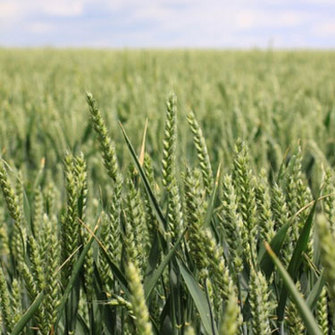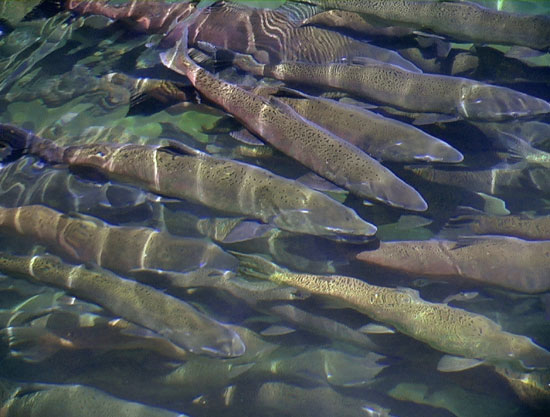« Prev Next »
Semelparity

Examples of short-lived semelparous species include annual and biennial plants (including all grain crops, and many herbaceous vegetables), and certain invertebrate species, including many spiders (Figure 1). There are even a few semelparous marsupial mammals in Australia. It is important to note that while all annual plants are semelparous, not all perennial plants are iteroparous. There are a wide variety of plant and animal species that live for many years before a single, massive, fatal reproductive episode (certain species of salmon, bamboo, and century plants, Figure 2).
Dilemma and Cost of Reproduction
Natural selection maximizes total lifetime reproductive output. So how could evolution ever favor programmed death after first reproduction? A key clue lies in the observation that semelparous species typically produce more offspring in their single reproductive episode than closely related species do in any one of theirs. It appears that when an organism does not need to withhold some resources to ensure future survival and reproduction, it can mobilize virtually all available resources to put into a single, massive reproductive episode. For example, this fecundity advantage is two to fivefold in plants. So the essential question becomes, "Under what conditions does the increase in fecundity associated with semelparity more than compensate for the loss of potential subsequent reproductive episodes?"

Theoretical Approaches
This question has been the subject of a rich theoretical literature. These models fall into three classes, all of which assume a tradeoff between reproduction and survival:
- Demographic models predict that when adult survival is low enough (relative to juvenile survival), evolution should abandon withholding resources for a future reproduction that is unlikely, and instead favor semelparity (Figure3).
- Bet-hedging models predict that when adult survival is highly variable, evolution should favor iteroparity, because it does not risk putting all reproductive effort into a single reproductive episode.
- Models incorporating non-linear patterns of reproductive costs and benefits predict that semelparity should be more likely to evolve when most of the costs of reproduction (reduction in future survival or reproduction caused by increases in current reproduction) happen even at low levels of reproductive effort, or conversely, when the benefits of reproduction accrue most rapidly at high levels of reproductive effort.

Empirical Evidence
Despite the abundance of theoretical models for the evolution of semelparity, direct empirical tests for each remain limited. For example, many species of annual plants are desert species or weedy species that are early arrivals after disturbance in many ecosystems. Both of these groups are subject to high variation in survivorship, in opposition to the predictions of the bet-hedging model.
In a particularly elegant test of the non-linearity model, it was demonstrated that the taller inflorescences of semelparous yucca species produced disproportionately more seeds than smaller inflorescences, but that this was not true in iteroparous yucca species. Similarly, pollinators preferred taller inflorescences of semelparous yucca species, but not iteroparous species. Although this observation fits the non-linear theory nicely, it has been pointed out that many of these species may not be pollinator-limited, and that inflorescence height patterns may be physiological consequences of life history differences, and not their evolutionary causes.
Synchronous Semelparity
There is an unusual pattern in semelparous plants characterized by single-aged populations that live for many years, then synchronously flower and die. Certain bamboos species are well known to exhibit this pattern, but other examples include certain palm species, shrubs in the family Acanthaceae, and even a tropical forest canopy tree. All of these grow in mesic forests that are climatically more moderate than the extreme environments characteristic of most semelparous species (e.g., deserts, alpine habitats, bogs, disturbed sites). Periodic cicadas in the eastern U.S. also exhibit this pattern. Predator satiation has been invoked to explain both synchrony and semelparity in these species, but there is no widespread consensus on its causes.
Species "Approaching" Semelparity
Semelparity in Grain Crops
Given our dependence on semelparous species, it is important that we better understand the evolution and physiology of this curious life history.
References and Recommended Reading
Arizaga, S. & Ezcurra, E. Insurance against reproductive failure in a semelparous plant — bulbil formation in Agave macroacantha flowering stalks. Oecologia 101, 329–334 (1995).
Bell, G. On breeding more than once. American Naturalist 110, 57–77 (1976).
Brenchley, J. L., Raven, J.A. et al. A comparison of reproductive allocation and reproductive effort between semelparous and iteroparous fucoids (Fucales, Phaeophyta). Hydrobiologia 327, 185–190 (1996).
Bulmer, M. Theoretical evolutionary ecology. Sunderland, MA: Sinauer & Associates, 1994.
Charnov, E. L. & Schaffer, W.M. Life history consequences of natural selection: Cole's result revisited. American Naturalist 107, 791–793 (1973).
Christiansen, J. S., Praebel, K. et al. Facultative semelparity in capelin Mallotus villosus (Osmeridae): an experimental test of a life history phenomenon in a sub-arctic fish. Journal of Experimental Marine Biology and Ecology 36, 47–55 (2008).
Cole, L. C. The population consequences of life history phenomena. Quarterly Review of Biology 29, 103–137 (1954).
Crespi, B. J. & Teo, R. Comparative phylogenetic analysis of the evolution of semelparity and life history in salmonid fishes. Evolution 56, 1008–1020 (2002).
Davies, R. W. & Dratnal, E. Differences in energy allocation during growth and reproduction by semelparous and iteroparous Nephelopsis obscura (Erpobdellidae). Archiv fur Hydrobiologie 138, 45–55 (1996).
Grossberg, R. K. Life-history variation within a population of the ascidian Botryllus schlosseri. I. The genetic and environmental control of seasonal variation. Evolution 42, 900–920 (1988).
Hamilton, M. B. & Mitchell-Olds, T. The mating system and relative performance of selfed and outcrossed progeny in Arabis fecunda (Brassicaceae). American Journal of Botany 81, 1252–1256 (1994).
Isbell, L. A., Young T. R. et al. Demography and life history of sympatric patas monkeys (Erythrocebus patas) and vervets (Cercopithecus aethiops) in Laikipia, Kenya. International Journal of Primatology 30, 103–124 (2009).
Janzen, D. H. Why bamboos wait so long to flower. Annual Review of Ecology and Systematics 7, 347–391 (1976).
Jones, M. E., Cockburn, A. et al. Life-history change in disease-ravaged Tasmanian devil populations. Proceedings of the National Academy of Sciences, 105, 10023–10027 (2008).
Klinkhamer, P. G. L., Kubo, T. et al. Herbivores and the evolution of the semelparous perennial life-history of plants. Journal of Evolutionary Biology 10, 529–550 (1997).
Kohno, K. Possible influences of habitat characteristics on the evolution of semelparity and cannibalism in the hump earwig Anechura harmandi. Research in Population Ecology 39, 11–16 (1997).
Lesica, P. & Young, T. P. Demographic model explains life history evolution in Arabis fecunda. Functional Ecology 19, 471–477 (2005).
Oakwood, M. & Bradley, A. J. Semelparity in a large marsupial. Proceedings of the Royal Society of London B 268, 407–411 (2001).
Ranta, E., Tesar, D. et al. Environmental variability and semelparity vs. iteroparity as life histories. Journal of Theoretical Biology 217, 391–396 (2002).
Sano, Y. H. & Morishima, H. Variation in resource allocation and adaptive strategy of a wild rice Oryza perennis (Muench.). Botanical Gazette 143, 518–523 (1982).
Schaffer, W. M. & Schaffer, M. V. The adaptive significance of variations in the reproductive habit in the Agavaceae II: Pollinator foraging behavior and selection for increased reproductive expenditure. Ecology 60, 1051–1069 (1979).
Schneider, J. M. & Lubin, Y. Does high adult mortality explain semelparity in the spider Stegodyphus lineatus (Eresidae)? Oikos 79, 92–100 (1997).
Silvertown, J. Are sub-alpine firs evolving towards semelparity? Evolutionary Ecology 10, 77–80 (1996).
Stearns, S. C. The Evolution of Life Histories. Oxford, UK: Oxford University Press, 1992.
Takada, T. Evolution of semelparous and iteroparous perennial plants: comparison between the density-independent and density-dependent dynamics. Journal of Theoretical Biology 173, 51–60 (1995).
Wilbur, H. M. & Rudolf, V. H. W. Life-history evolution in uncertain environments: bet hedging in time. American Naturalist 168, 398–411 (2006).
Williams, J. L. Flowering Life-history strategies differ between the native and introduced ranges of a monocarpic perennial. American Naturalist 174, 660–672 (2009).
Woolhead, A. S. & Calow, P. Energy partitioning strategies during egg production in semelparous and iteroparous triclads. Journal of Animal Ecology 48, 491–499 (1979).
Young, T. P. A general model of comparative fecundity for semelparous and iteroparous life histories. American Naturalist 118, 27–36 (1981).
Young, T. P. The evolution of semelparity in Mount Kenya lobelias. Evolutionary Ecology 4, 157–171 (1990).
Young, T. P. & Augspurger, C. K. Ecology and evolution of long-lived semelparous plants. Trends in Ecology and Evolution 6, 285–289 (1991).
Zeineddine, M. & Jansen, V. A. A. To age, to die: parity, evolutionary tracking and Cole's paradox. Evolution 63, 1498–1507 (2009).































